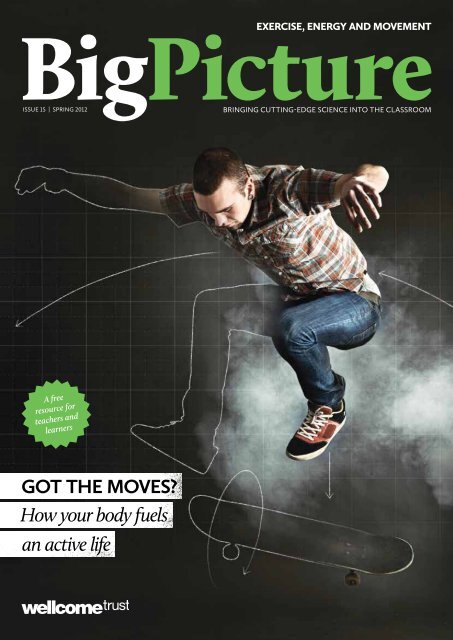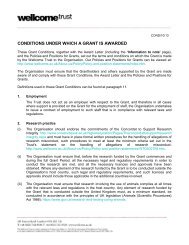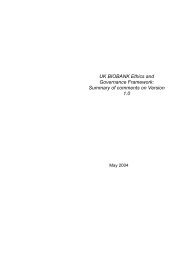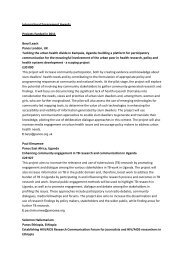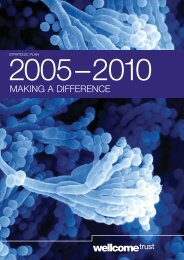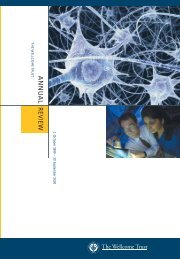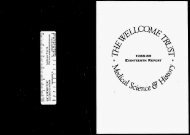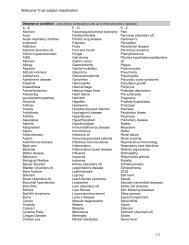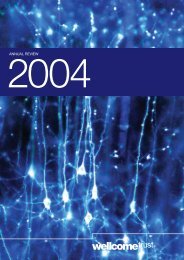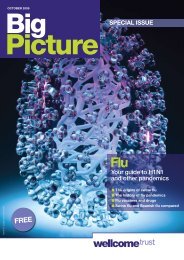Big Picture: Exercise, Energy and Movement - Wellcome Trust
Big Picture: Exercise, Energy and Movement - Wellcome Trust
Big Picture: Exercise, Energy and Movement - Wellcome Trust
Create successful ePaper yourself
Turn your PDF publications into a flip-book with our unique Google optimized e-Paper software.
Made to moveAnimals swim, creep, fly, walk or run to find food <strong>and</strong>shelter, to hunt <strong>and</strong> fight, <strong>and</strong> to escape from danger.Humans move for the same reasons, but there arepeculiarities about our locomotion. The reasons forthe way we move <strong>and</strong> how we developed our uprightgait are still argued about by researchers.If your skeleton were taken away,your organs would be in an untidyheap on the floor. But your skeletonis much more than a simplesupport for your softer parts – bytransmitting force <strong>and</strong> providingleverage, it allows you to move.The centres of the long bones(such as those in the arms <strong>and</strong> legs)are hollow, which makes themstrong yet light. The cavity insidethe bone is filled withbone marrow, whereblood cells are made.In childhood, theends of the longMost animals get around fineon four, six or eight legs. Sowhat made us bipedal, walking<strong>and</strong> running on just two? It isunlikely that we will ever knowthe real answer, but by studyingour closest living relatives, thegreat apes, alongside fossil data,we can begin to build a pictureof how our common ancestormay have moved.One prevailing currentBare bonesWhat are our skeletons for?Two legs good?Why did humans evolve to be bipedal?bones in our arms <strong>and</strong> legs, whichnormally go on growing for 17 yearsor so, are made mainly of cartilage.This softer tissue gradually becomescalcified as it turns into the solid,but still spongy, tissue of maturebone. By then, cartilage is left onlyat the ends, where it eases jointmovements. Even when calcified,bones are still living tissue. Bone –particularly the protein <strong>and</strong> mineralof the bone matrix – is continuallyremodelled <strong>and</strong> replaced inresponse to the stresses<strong>and</strong> strains ofmovement.theory is that we evolvedfrom an ancestor that movedaround using quadrupedalknuckle-walking, much likeour African ape relatives(chimpanzees, bonobos <strong>and</strong>gorillas) do today. Later, ourancestors stood up <strong>and</strong> beganto move around on two legs.Various reasons for this havebeen proposed, includingimproved fighting ability,improved carrying ability orreaching food on low branchesfrom the ground. Recent fossilevidence, however, suggeststhat we spent more time in thetrees than previously thought.Orang-utans are the mostarboreal (tree-dwelling) of thegreat apes, <strong>and</strong> recent studiesshow that they use a humanlikeform of straight-leggedbipedalism to move aroundCHANGE IS AFOOTWhat changed when we began towalk on two legs?The switch to modern human locomotiongoes along with a set of changes in ourskeleton, tendons, ligaments <strong>and</strong> muscles.We are adapted for walking, but we are alsoadapted for upright running. Compared toother running animals, humans are poorsprinters but outst<strong>and</strong>ing long-distancerunners. We stay cooler <strong>and</strong> tire less quicklythan quite a few animals that are preyfor hunter–gatherer tribes. Some tribes,including those in the Kalahari Desert, stillcatch their meat by running down animalssuch as deer <strong>and</strong> antelope.One of our bipedal ancestors wasAustralopithecus afarensis, which livedbetween two <strong>and</strong> four million years ago.Modern humans’ anatomy has changed,making running easier for us than it wouldhave been for Australopithecus. Thesemodifications include changes to the head,shoulders <strong>and</strong> spine, a longer trunk <strong>and</strong>legs, shorter forearms <strong>and</strong> larger, moremuscular buttocks. We also have a longer,more elastic Achilles tendon <strong>and</strong> haveundergone changes to the heel bone <strong>and</strong>big toe.There was also a complex seriesof changes in the bones of the pelvis,including it becoming narrower, whichprobably gave increased running efficiency.Because babies pass through the pelvis,humans had to enter the world earlier <strong>and</strong>earlier in gestation as their brains increasedin size. Otherwise, birth would havebeen too risky for mother <strong>and</strong> child. Ournewborn helplessness, <strong>and</strong> long dependencyas infants, may come from the shift to anupright stance.on the very thin branches inthe trees to obtain food. So, wemight even have been usingsome form of bipedalism beforewe came down to the ground.MORE ONLINE: Read about which bones humans break most often <strong>and</strong> why at www.wellcome.ac.uk/bigpicture/exercise<strong>Wellcome</strong> Library<strong>Wellcome</strong> Librarynano/iStockphotoOut of this worldLong-term low gravity can seriously affect usWhen we move around in low or zero gravity, the mechanical strainapplied to our skeleton is much lower than on Earth. This is why movingaround in low-gravity environments, such as space, gradually depletesbone mass. Muscle atrophy (wasting) is also a problem <strong>and</strong> begins evenon short missions (see more on muscles on pages 6 <strong>and</strong> 7). Crew on theInternational Space Station can spend six months in orbit <strong>and</strong> have toexercise for hours every day on special equipment to reduce muscleloss; they also have to follow an exercise programme when they returnto Earth. A human mission to Mars would take almost a year, <strong>and</strong>mission planners will have to include some high-tech gym kit on thecraft to maintain the muscles <strong>and</strong> bones of those on board.MakE OR BREAKWhat factors affect bone strength?What we eat <strong>and</strong> how much we move about affects how strong our bones are. Jumpingstrengthens the bones more than running, for example, because the bones are under agreater load. More than two-thirds of bone by weight is made of calcium phosphate crystalsembedded in the matrix that bone cells build. High-calcium foods <strong>and</strong> drinks like cheese <strong>and</strong>milk help raise peak bone mass, a key factor in delaying the onset of osteoporosis. VitaminD is important, too, because it helps calcium absorption. We make most of the vitamin D weneed through exposure to sunlight. Darker skin takes more time in sunlight to make vitaminD than lighter skin, so some dark-skinned people living in temperate countries may needextra vitamin D in their diet to make up for the lack of strong sunlight.Walk like a manWhat steps are involved in walking?Walking may seem as simple as puttingone foot in front of the other. Analysethe motion, though, <strong>and</strong> at any one timeyou are balanced on one leg as you moveforward. That leg pivots around the plantedfoot <strong>and</strong> transmits force from the groundup to your hipbones, initially slowing youdown. As you slow, you also push upwards,then you start to accelerate again. Youmight simply fall forwards, but you swingthe other foot in front of you just in timeto begin the next step. The degree to whichbouncing, by flexing tendons in the leg <strong>and</strong>foot, is involved in walking (as it definitelyis in running) is still being studied bybiomechanics experts.Watch a toddler taking their first steps,or someone recovering from a strokelearning how to walk again, <strong>and</strong> it’s clearthat the co-ordination needed is trickyto master. Constant small adjustmentsFAST FACTare needed to keep a person upright <strong>and</strong>moving forward. The patellar, or knee-jerk,reflex is routed through the spinal nervesfor speed so that it can contract thethigh muscles almost instantlywhen the foot is loaded.Without that contraction, youwould stumble at every step.Walking also needs goodproprioception, or a sense ofexactly where your body is inrelation to your surroundings.Losing this sense is why you loseyour footing if there is one more– or one less – step in a flight ofstairs than you thought.Robots that mimic humanwalking are now available.For one example, seewww.<strong>and</strong>rew.cmu.edu/user/shc17/Robot/Collins_2005_Science.pdf.Studies have shown that smokers have significantly reduced bone masscompared to non-smokers. According to estimates, this increases thelikelihood of needing a hip replacement by 31 per cent in women <strong>and</strong> 40 percent in men. Source: Ward <strong>and</strong> Klesges. Calc Tissue Int 2001;68:259–270Collins et al (2005), ScienceThinning bonesAge <strong>and</strong> diet can contributeto thinning bonesBone strength is maintained if boneis replaced at the same rate as oldbone is removed. When the layingdown of new bone cells slackens,the bones become thinner. In ourlate teens, the mass <strong>and</strong> density ofour bones reaches its peak, thenslowly declines with age. Olderpeople, therefore, have thinnerbones; combined with a decreasein muscle mass, this leaves elderlypeople prone to injuries from falls.Some 75 000 broken hips are treatedin the UK per year – mostly in olderwomen. The depletion of boneis known as osteoporosis <strong>and</strong> ismore common in women, probablybecause of hormonal changeslinked to the menopause. Verystrenuous exercise can also disturbthe balance between bone removal<strong>and</strong> renewal in athletes. This putsthem at risk of stress fractures,which leave hairline breaks in bonesput under load.There is evidence that somefizzy drinks can speed up bonethinning. In one study, regularcola drinking was linked tolower bone density in women, forexample, although the reasonsfor this are somewhat unclear. Itcould be because cola features indiets that are otherwise low incalcium or because such drinkscontain phosphoric acid, whichis known to bind to calcium <strong>and</strong>magnesium in the gut, reducingabsorption of the minerals.4 | BIG PICTURE 15: EXERCISE, ENERGY AND MOVEMENT Spring 2012 | 5
Muscles <strong>and</strong> movementWe each have hundreds of muscles, <strong>and</strong> these specialisedbundles of proteins are involved in all kinds of biologicalprocesses – from locomotion to pumping blood around ourbody <strong>and</strong> from squeezing food through the digestive tractto controlling how much light enters the eye. So what domuscles look like? How are they made? How do they work?Know your typeOur bodies contain three main types of muscleWe move our bodies using skeletal(voluntary) muscles, the only onesthat we have conscious control over.Cardiac muscle in the heart <strong>and</strong>smooth muscle, which lines organslike the stomach, bladder <strong>and</strong> uterus,are involuntary. These muscles,controlled by the autonomic nervoussystem, work without us needing tothink about it.There are many skeletal muscles,large <strong>and</strong> small. They all pull onbones for leverage but are adaptedfor different uses. ‘Slow’ musclefibres have a richer blood supply <strong>and</strong>use oxygen to help release energy.‘Fast’ fibres contract more rapidlybut fatigue more quickly as well. Thefastest use hardly any oxygen directly– they are anaerobic, extractingenergy from organic moleculesstored in their cells.Most muscles havea mixture of fibretypes, <strong>and</strong> somespecialised muscleshave more of onethan the other.The musclesthat move youreyes, for example,contain mostlyfast-twitch fibres.Think of chickenmeat: chicken wings,used for short efforts inflight, have mostly fast-twitchmuscle fibres. Their meat iswhite because the wing musclesrequire relatively little oxygen.Chicken legs, by contrast, arecontracting all the time <strong>and</strong>are mainly slow-twitch. Theiroxygen use is greater <strong>and</strong> the meat isredder because it contains a greaterconcentration of the pigmentedprotein myoglobin, which carriesoxygen.Naturally, people have differentproportions of muscle fibre types.Different sports make use of differenttypes too; for example, sprinters,throwers <strong>and</strong> weightlifters rely onbursts of power from muscles with ahigh proportion of fast-twitch fibres.Someone with many slow-twitchfibres is unlikely to break recordsover 100 metres, <strong>and</strong> someone witha higher proportion of fast-twitchmuscle fibres will have a harder timegetting in shape for a marathon. Inboth cases, though, training will makethe person better at whatthey’re working towards<strong>and</strong> will cause changesin the appropriate type ofmuscle fibre.Some differencesin muscle type areinherited. In 2003,for example, oneresearch groupfound that avariant in a geneaffecting musclefibres, known asACTN3, was morecommon among asample of elite athletesin speed events thanin those requiringendurance.www.ncbi.nlm.nih.gov/pubmed/12879365Molecular motorsMinuscule motors are behindmuscle contractionLaguna design/Science Photo LibraryMuscle fibres contain protein molecularmotors. These are nanoscale machines(around one-millionth of a millimetrein size) that perform several tasks insideall cells, such as transporting material ormoving chromosomes during cell division.All work on the same basic principle: aprotein molecule binds to <strong>and</strong> hydrolysesthe energy-rich chemical called adenosinetriphosphate (ATP). The energy released isused to change the protein’s shape. Repeatthe cycle <strong>and</strong> you have a regular movement.A muscle cell (fibre) is made up ofmyofibrils, bundles of protein that includeactin <strong>and</strong> myosin. Muscle movement ispowered by a change in shape of the myosin(pictured above). The myosin head binds toactin <strong>and</strong> breaks down ATP. This releasesenergy that pulls the actin filaments along.Myosin then disconnects. The musclecontracts, not because the filamentsshorten, but as actin <strong>and</strong> myosin filamentsslide past one another.In skeletal muscle, the contraction isstarted by a rise in the concentration ofcalcium ions, triggered by the arrival of aneurotransmitter (a chemical signal) fromthe nerve ending that attaches to eachmuscle cell at the neuromuscular junction.The calcium ions, in turn, interact with twoother proteins, troponin <strong>and</strong> tropomyosin.These two proteins change shape to allowmyosin to bind to actin. The myosin headstilt, which pulls up the actin <strong>and</strong> causes themuscle to contract. See an animation onthis at www.wellcome.ac.uk/bigpicture/exercise.Wasting awayDiet, injury <strong>and</strong> a lack of use can affect our musclesMuscle can shrink as well as grow, <strong>and</strong>some reduction in muscular strengthis a normal part of ageing. <strong>Exercise</strong> canslow this but not prevent it completely,<strong>and</strong> poor diet tends to speed it up.Serious muscle wasting, or sarcopenia,usually involves the loss of myosin (asit is removed <strong>and</strong> not replaced) <strong>and</strong> theloss of some of the mitochondria, whichproduce the adenosine triphosphate(ATP) on which muscle power relies.Malnutrition, especially getting too littleprotein to eat, can cause muscle wastingat any age. Kwashiorkor is one exampleof a childhood disease that involvesmuscle wasting. A low-protein diet isamong its causes.Just a few weeks’ bed rest duringillness can cause long-lasting muscleloss, especially in older people. It iscaused by the combination of a dropin manufacture of new protein <strong>and</strong>an accelerated breakdown of existingmuscle fibres. The effects are worst inthe legs <strong>and</strong> back, which normally holdus up against gravity, <strong>and</strong> can quicklylead to immobility.Involuntary movementWhy do we sometimes move without meaning to?The nerve impulses that make skeletalmuscles move are under consciouscontrol, most of the time. Losingthat control can be harmless, such asshivering in the cold, or more serious,as a result of diseases that affect thenervous system. A well-known exampleis Parkinson’s disease, in which cellsthat make the neurotransmitterdopamine gradually disappear fromMaking musclesWhat can we do to build muscle?Regular exercise makes skeletalmuscles grow. If you work a muscleagainst a larger load than usual, it willget stronger, provided you are eatingthe right kind of food. You need a goodsupply of amino acids (the buildingblocks of proteins) after exercise.Without it, a heavily worked musclecan use up more protein, for part ofRhabdomyolysis is the breakdownof muscle <strong>and</strong> can be caused by manyfactors, including crush injuries (forexample, when part of the body issqueezed between two heavy objects),cocaine abuse <strong>and</strong> exercise. Muscledamage leads to the release of thepigmented protein myoglobin intothe bloodstream <strong>and</strong> in severe casescan cause distinctive brown urine (seebelow) <strong>and</strong> even acute kidney failure.The link between kidney failure<strong>and</strong> crush injury was first made byProfessor Eric Bywaters, who noticedbrown urine in people hurt during theLondon Blitz in World War II.wellc.me/rZBT2aone brain region, the substantia nigra.Early symptoms of Parkinson’s diseaseinclude too much movement (shaking)<strong>and</strong> too little (freezing or rigidity). Incases of Tourette syndrome, movementis normal most of the time, butpeople with this complex conditionsometimes have involuntary, repetitivetics, often involving the facial musclesor shoulders.its energy supply, than it is able to laydown. The growth is mainly specific tothe muscle doing the work, so differenttraining regimes produce differentresults. Formula 1 drivers are generallyfit but lightly built; however, theyhave large neck muscles because theyhave to hold their heads against largeg-forces on fast corners.James Heiman, MD/Wikipedia© Oleksiy Maksymenko/AlamyFAST FACTTitin is a key part of striated muscle, whichallows muscles to stretch. Containing upto 34 350 amino acids <strong>and</strong> named after theGreek Titans, titin is the largest knownhuman protein. Source: www.expasy.orgAthletic heartsyndromeThe heart is a muscle, whichcan grow with exerciseSkeletal muscles grow if they are workedharder, <strong>and</strong> so does the heart muscle.Increased cardiac efficiency goes withgetting fit – but can it go too far? The leftventricle is the main pumping chamberof the heart, <strong>and</strong> athletes who trainhard for hours every day tend to havemore powerful left ventricles, with moremuscle, thicker walls <strong>and</strong> a larger bloodpumpingchamber. This goes along witha slower resting heart rate, as each beatmoves more blood. These changes havebeen called ‘athletic heart syndrome’<strong>and</strong> are normally harmless; however,athletic heart syndrome looks similaron several st<strong>and</strong>ard heart tests to aninherited enlargement of the heart muscle,hypertrophic cardiomyopathy, which canlead to heart weakness.A small number of sudden deaths duringsports events in people who seemed fit<strong>and</strong> had no diagnosis of heart disease arecaused by cardiomyopathy. Athletes withenlarged hearts may find their doctors wantto examine them very closely because ofthe similarities in appearance between thetrained <strong>and</strong> malformed heart. A decisivedifference is that an athlete who takes abreak from training will find their heartreverts to normal size, whereas the heart ofsomeone with cardiomyopathy will not.boghog2/WikipediaMORE ONLINE: Check out our free ‘In the Zone’ experiment kits. For ages 14–16, explore the strength of your muscles <strong>and</strong> discover how they are used during movement. See more at www.getinthezone.org.uk6 | BIG PICTURE 15: EXERCISE, ENERGY AND MOVEMENT Spring 2012 | 7
Fuel for lifeRun as fast as you can for as long as you can. Why do youeventually stop? Probably not because of sore muscles orfeeling tired. You get out of breath. As you st<strong>and</strong> there, bentover, sucking in air, you are showing that muscles needoxygen to move. But what do we use this oxygen for <strong>and</strong>how do we measure how much we can use?Take a deep breath…How do we measure how much oxygen we can use?Work your muscles hard, <strong>and</strong> you will need more oxygen. Yourbrain’s respiratory centre sends signals to the diaphragm <strong>and</strong>intercostal muscles to breathe more air in <strong>and</strong> expel it faster, affectinghow deeply <strong>and</strong> how fast you breathe. These aren’t the only factorsaffecting how much oxygen you can use. Also important is how fast <strong>and</strong>how much blood your heart can pump, how dense the red cells (whichcarry oxygen) are in your blood, how efficient the blood supplyis to your muscles, <strong>and</strong> how efficiently your muscles can use the oxygen.VO2 max is a measure of the maximum amount of oxygen (in millilitres) youcan use per kilogram of body weight per minute. Men who do not train averagearound 45 ml/kg/min, <strong>and</strong> it is slightly lower for women, at 38 ml/kg/min (seetable). Athletes commonly record values in the 70s, <strong>and</strong> a few exceptional peoplemay reach into the 90s. The highest values have been seen in cross-country skiers.Fast animals can have much higher VO2 max than humans. Thoroughbred horsesoften reach 180 ml/kg/min; sled dogs, bred for strength <strong>and</strong> endurance, canregister 240 ml/kg/min; <strong>and</strong> the pronghorn antelope (above right) beats them allwith 300 ml/kg/min.VO2 max is not the only thing that determines top speed. You have to dissipateheat from your muscles, for example. This is easier for a mouse, which has a highsurface area relative to its mass, than a human. However, VO2 is a good measureof general fitness.Different physiological measures for average men <strong>and</strong> women versus elite cyclistsMeasure Average man Average woman Elite cyclist 1Total lung capacity (litres) 6 4.2 8 2VO2 max (ml/kg/min) 45 38 88 2Resting heart rate (beats/min) 64–72 72–80 32–34 31. Man trained for endurance racing2. Miguel Indurain, who won five consecutive Tours de France3. Lance Armstrong, who won seven consecutive Tours de FranceSources:news.bbc.co.uk/1/hi/6273202.stmwww.bbc.co.uk/science/humanbody/body/factfiles/heart/heart.shtmlFAST FACTRigor mortis (body stiffness a few hours after death)is caused by a lack of adenosine triphosphate (ATP).During muscle contraction, ATP releases myosinfrom actin. After death, when ATP sources becomeexhausted, the muscles cannot relax <strong>and</strong> rigor mortissets in. The muscles relax only when the body beginsto decompose. Source: www.jstor.org/pss/4450701VikaValter/iStockphoto© Radius Images/AlamyStep in timeFeeling the rhythm might help youkeep runningMost animals show a breathing rhythm thatis tied to their movements – a link knownas entrainment. Humans can synchronisebreathing with walking or running as well,but we do not have to. This may be becauseour bipedal gait puts fewer constraintson the muscles that work the lungs. Thediaphragm is the most important muscle forbreathing in. During quiet breathing (e.g.when we’re at rest), inspiration (breathingin) occurs when the diaphragm <strong>and</strong> otherrespiratory muscles contract. Expiration(breathing out) happens through relaxingthe diaphragm <strong>and</strong> elastic rebound of thelungs themselves. The faster <strong>and</strong> moredeeply you are breathing, the more themuscles of the abdomen <strong>and</strong> those betweenthe ribs contribute to breathing in <strong>and</strong> out.Letting your breathing rhythm fall inwith your stride is not necessarily moreefficient, but it seems to happen naturallyfor many runners. Part of the impacton running may be psychological. Therhythmic breathing can provide distractionfrom the discomfort of the exercise.Known as a ‘pseudo-mantra’, this can be auseful technique for someone trying to getinto training.Something to say?Is our move to two legs linked to ourability to speak?The way we talk depends on the way webreathe. Most primates breathe in constantrhythm, <strong>and</strong> their vocal sounds are limitedto one per breath. Humans, however, caninterrupt the rhythm when we choose<strong>and</strong> produce a whole string of syllablesas we breathe out. This escape fromtight, rhythmic control of breathing mayhave been important in the evolution oflanguage. It may also be linked to the shiftfrom involuntary to voluntary coupling ofbreathing <strong>and</strong> stride rhythm, which wentalong with our move to bipedal (twolegged)movement.Some musicians take the longexhalations of speech a step further.Wind players such as trumpeters <strong>and</strong>saxophonists can learn ‘circular breathing’,a technique that dem<strong>and</strong>s breathing inthrough the nose while expelling air fromthe mouth using muscular pressure fromthe cheeks. This allows players to sustaina continuous stream of notes.NO OXYGEN?<strong>Energy</strong> can be released from food without oxygenGlycolysis is the initial breakdown of glucose, which happens in the cell’scytoplasm <strong>and</strong> needs no oxygen – it is anaerobic. It is a complex process inwhich the six-carbon glucose molecule eventually yields products includingtwo molecules of adenosine triphosphate (ATP) <strong>and</strong> two molecules ofthree-carbon pyruvate. From here, respiration can continue anaerobically oraerobically, using oxygen (see ‘aerobic workout’, right).The process to extract energy from food anaerobically (without oxygenor mitochondria) evolved long before aerobic respiration, when there wasno oxygen in Earth’s atmosphere. It remains in operation alongside aerobicrespiration in organisms that are evolutionarily more recent. For more, seethe poster accompanying this issue.Feeling soreWhy might exercise leave us sore?Your muscles may feel sore after energeticexercise if you are not used to it. Oftenthis occurs a while after you stop <strong>and</strong> canlast for two or three days. This delayedonsetsoreness is more than mere stiffnessbut less than the major pain from a tornAnalogy using money to show how ourbodies store different forms of energy.In order of most readily accessed to least,from top: cash for instant use (ATP),money from an ATM (blood glucose),savings account (muscle <strong>and</strong> liverglycogen), <strong>and</strong> gold, a fixed asset (fat).muscle. Although it used to be blamed ona build up of lactic acid from anaerobicenergy supply, a more likely explanationis that unaccustomed exercise produces alot of small tears in muscle fibres, whichlead to mild inflammation before they areFAST FACTTissues with large but variableenergy dem<strong>and</strong>s, such as skeletalmuscle, spermatozoa <strong>and</strong> the brain,store energy for instant availabilityas phosphocreatine. This reversiblytransfers a phosphate group toadenosine diphosphate (ADP) to makeadenosine triphosphate (ATP).Source: www.uniprot.org/uniprot/P06732Aerobic WORKOUTThe main way our bodies get energyrequires oxygenAerobic respiration uses oxygen to breakdown glucose, amino acids <strong>and</strong> fatty acids<strong>and</strong> is the main way the body generatesadenosine triphosphate (ATP), whichsupplies energy to the muscles. Afterglycolysis (the anaerobic breakdownof glucose into pyruvate), pyruvate isconverted to acetyl CoA in the matrix ofthe energy-transferring mitochondria, inthe link reaction. Next is the Krebs cycle,which occurs twice per glucose molecule,producing – among other chemicals thatfeed into the aerobic part of the process –more ATP molecules.The aerobic part of the process dependson a series of enzymes that are organisedalong the folds of inner membranes(cristae) of the mitochondria. The enzymesare arranged so that electrons pass fromone reacting molecule to the next, ina series of steps known as the electrontransfer chain. This process ends with ATPsynthase, an enzyme that produces ATPfrom adenosine diphosphate (ADP) <strong>and</strong>inorganic phosphate – up to around 30molecules of ATP per molecule of glucose,according to current thinking – <strong>and</strong>captures the final portion of the energyreleased by the whole complex of reactionsin a form that the rest of the cell can use.repaired. Typically, this soreness occursafter lots of eccentric contractions, wherethe muscles lengthen under tension (e.g.lowering a weight in a biceps curl). This iswhy hillwalking makes your muscles morestiff than flat walking.Miles Kelly Art LibratyMORE ONLINE: Fossilised Check out bones our free show ‘In humans The Zone’ were experiment butchering kits. meat For 3.5 ages million 16–19, years explore ago. how Read the more cardiovascular at www.wellcome.ac.uk/bigpicture/foodsystem adapts during different activities. For ages 11–14, discover how exercise affects your breathing. See more at www.getinthezone.org.uk8 | BIG PICTURE 15: EXERCISE, ENERGY AND MOVEMENT Spring 2012 | 9
Fit in mind <strong>and</strong> body?Being fit sounds good, but what do we mean by it? In everyday language, things can be fit for useor simply a good fit, like a pair of jeans. Physical fitness is hard to define by itself. It might meansome combination of power, speed, endurance <strong>and</strong> flexibility. We tend to associate physical fitnesswith feeling healthy, so there is a mental component as well.Everything in moderation?What do we need to do to be healthy?It’s easy to say that moderate exercise mustbe good for everybody, but one emergingidea is that the best way to keep healthy isto lead an active lifestyle (using the stairs,walking more, <strong>and</strong> so on) <strong>and</strong> top this upwith short bursts of intense exercise. Acompletely sedentary lifestyle is dangerousbut not necessarily the same as a lifelacking a formal exercise regime.If the most simple definition of fitnessis staying alive for longer, the benefits ofstaying active are pretty clear. An activelifestyle cuts the risks of heart disease,stroke, <strong>and</strong> Alzheimer’s disease <strong>and</strong>dementia. It can also help you combatobesity if you don’t eat more calories thanyou burn off. Reducing obesity, in turn,reduces your risk of cancer <strong>and</strong> diabetes<strong>and</strong> results in stronger bones.How do we know what we should do tobe healthy? Often, guidelines are based onepidemiological data, gained by observinglarge populations. Some researchers arguethat interventional studies – where specifictreatments or behaviours are applied <strong>and</strong>tested – will give us all a firmer idea ofwhat really works to keep us healthy.Wearing outIs the future grow-your-own?Many people now have their worn jointsfixed with metal <strong>and</strong> plastic substitutes– operations that could be avoided if wewere able to regrow bone <strong>and</strong> cartilage toreplace worn-out parts. That is one possibleapplication for stem cells, versatile cells thatcan be nurtured to develop into differenttypes of tissue. If they are grown in the lab onthe right kind of scaffold, bone stem cells can,in theory, generate new bone. At the moment,the cells are grown on donated bone fromearlier operations, but the search is on forartificial materials that will do the job.The aim is to make scaffolds that are assimilar to natural bone matrix as possibleNHS Guidelines for physical activitiesUnder 5s• Children who can walk alone should be physically active for at least 180minutes every day.Ages 5–18• At least 60 minutes of mixed moderate-intensity <strong>and</strong> vigorous-intensityaerobic activity <strong>and</strong> muscle- <strong>and</strong> bone-strengthening activities, every day.19 <strong>and</strong> over• At least 150 minutes of moderate-intensity aerobic activity every week <strong>and</strong>muscle-strengthening activities on two or more days a week that work allmajor muscle groups or• 75 minutes of vigorous-intensity aerobic activity every week <strong>and</strong> musclestrengtheningactivities on two or more days a week or• a mixture of both.CLASSIFICATION OF ACTIVITIESModerate-intensity aerobic: Vigorous-intensity aerobic:cycling, fast walking, running, football, hockey,skateboarding, mowing skipping, martial artsthe lawnwww.nhs.uk/LiveWell/Fitness/Pages/Fitnesshome.aspx(i.e. that are biomimetic). They need to bemade of material that will degrade oncenew tissue has formed <strong>and</strong> that has theright mechanical <strong>and</strong> chemical properties.This is a very dem<strong>and</strong>ing specification,but the formulation of such materials isgradually improving. Naturally occurringmaterials can also help: a British companyis developing replacements for damagedcartilage, especially in knee joints, using anew material based on spider silk fibres. Formore, see wellc.me/uO2CrU.Muscle-strengthening:press-ups, weightliftingusing all major musclegroups<strong>Wellcome</strong> LibraryUnder strainExtreme exercise can be harmfulDoing an exercise programme on topof an active lifestyle can have costs – itcan make you tired or cause injuries.Injuries can occur when peopleexercise inappropriately (e.g. whenlifting weights the wrong way), so itmight be wise to get instruction <strong>and</strong>coaching <strong>and</strong> to allow your body toadapt slowly to new forms of exercise.Muscle sprains, muscle strains<strong>and</strong> stress fractures in bones oftenaffect athletes whose sport requirescontinual repetitive effort, such astennis players.Simple wear <strong>and</strong> tear is a risk forjoints, which bear a lot of the strain ofdifferent forms of exercise. Habitualrunners work their knees hard, <strong>and</strong>running has previously been linkedto arthritis in later life. More recentreviews, however, suggest that it isharmless at worst <strong>and</strong> might even begood for the joints in the majority ofpeople. Running after a knee injuryor while overweight does appear to beharmful, though, <strong>and</strong> weightlifters<strong>and</strong> football players have both beenMentally strong<strong>Exercise</strong> can change our mental stateDoing exercise affects our mentalstate, <strong>and</strong> vice versa. Just going fora stroll can improve your mood,<strong>and</strong> making yourself get out <strong>and</strong> beactive is important when you aredepressed or anxious. Trials showthat exercise can be as good for peoplewith depression as drugs, <strong>and</strong> animalstudies have found changes both inneurotransmitters <strong>and</strong> in the numberof some types of neurons when mice<strong>and</strong> rats are allowed to exercise freely.Feeling confident may also be linkedto a lower risk of injury during heavyexercise. In one study in which formerathletes were training the skills neededby their new employer, the Cirque duSoleil, more than half the traineeshurt themselves badly enough to seekhelp from the resident physical trainer.Those who had a low self-confidencescore on a st<strong>and</strong>ard questionnairewere more than twice as likely to hurtthemselves as those with a high rating(see more at www.ncbi.nlm.nih.gov/pubmed/21047839).found to suffer from arthritic knees inlater life. Football can be particularlydamaging because of the twisting <strong>and</strong>turning on the knee involved.Another general effect of veryfrequent <strong>and</strong> intense exercise shows upin the immune system: doing exerciseseems to boost the immune response,but overdoing it can have the oppositeeffect. Intense exercise – for example,a marathon – appears to make athletesmore susceptible to infections likecolds <strong>and</strong> sore throats. Part of thereason is release of the hormonecortisol, which helps us cope withstress by boosting glucose use but alsodamps down immune reactions <strong>and</strong>reduces inflammation.There is also evidence that longtermendurance exercise can do harmto the heart. A study of men who hadearned admission to the 100 MarathonClub found that the older among themhad some heart muscle scarring. Moreresearch is needed to underst<strong>and</strong> theimplications of this finding (www.ncbi.nlm.nih.gov/pubmed/21330616).The brain’s influence on exercisecan also be felt in the onset of fatigue.The sensations of exercise becomingharder, <strong>and</strong> then feeling exhausted,happen before the systems that driveexercise actually reach their limits.The signal to slow down or take abreak comes from the brain, processingall the information coming back fromthe hardworking muscles <strong>and</strong> organs<strong>and</strong> deciding it is time to ease off.Elite athletes can be trained to controltheir fatigue, to some extent, <strong>and</strong> sopush on harder <strong>and</strong> faster than theircompetitors in endurance events.At the extreme end of the exercisespectrum, competitors in the extremetriathlon event Ironman manage tofinish an event that would cause nonathletessevere pain. It is possible theyfeel pain less acutely after their intensetraining or that they are better atignoring it than non-competitors.FAST FACTExtrapolating from current data, womenwill be finishing before men in the 100 msprint at the 2156 Olympics. However, thisignores many factors that make this veryunlikely, including that men <strong>and</strong> womenmay reach a physiological limit regardingsprint speed. Source: Tatem et al. Science2004;431:525Goal!How you think can affect performancePeople often exercise with some end in view,<strong>and</strong> the goal you pursue can affect how youperform. Sports psychologists recognisedifferent types of goals. They may be positive,where you look for mastery of a particular skillso you can enjoy the achievement. Negativegoals, by contrast, involve avoiding being seento fail or to act incompetently. This can affectperformance: negative goals are less likely toget a good result, so the football striker whodwells on how terrible it would feel to miss apenalty may be thwarted by the goalkeepermore often.Location,location, locationDoes it matter where you exercise?What effect does where you exercisehave on you? This is tricky toinvestigate because just being in naturalsurroundings can have positive effectson people’s mood. Still, there is someevidence that being outdoors boosts thegood mood induced by a walk or a run,compared with the same amount of effortin the gym. Green l<strong>and</strong>scapes <strong>and</strong> wateralso seem to make people feel better aboutthemselves <strong>and</strong> more inclined to go outfor another session.technotr/iStockphoto© Ina Fassbender/Reuters/CorbisMORE ONLINE: For short videos on a range of topics related to exercise, energy <strong>and</strong> movement, see www.wellcome.ac.uk/bigpicture/exercise10 | BIG PICTURE 15: EXERCISE, ENERGY AND MOVEMENT Spring 2012 | 11
PeakperformanceHere, we explore some current <strong>and</strong> potentialfuture scenarios around the ethical, legal<strong>and</strong> social issues of sport <strong>and</strong> exercise.Limited knowledgeImprovement in sports records tends to level off, although astoundingathletes like sprinter Usain Bolt can still sometimes leap ahead ofeveryone else. Can we predict an ultimate limit to human performance?Mathematically, the technique to use here is called extreme valuetheory (see left). This allows statisticians to estimate how far theextreme of a probability distribution extends, even if we have notsampled it in reality. Applying this technique to the existing records oftimes over 100 metres indicates an ultimate limit of between 9.3 <strong>and</strong>9.5 seconds. Bolt’s current record st<strong>and</strong>s at 9.58, <strong>and</strong> he beat theprevious record holder by 0.16 seconds.Athletes improve through competition, but animals can be bredfor high performance. Even so, records tend to level off. Timings fromevents run over the same course for many years typically show onlyslow improvement. So any species, unaided, has performance limitsthat are unlikely to change. Humans, though, have technology, whichcan be a game-changer.FAST FACTA ban on performance-enhancing polyurethaneswimming suits was implemented by FINA (theinternational governing body for swimming)on 1 January 2010, after 29 world recordswere set in the first five days of the FINAWorld Championships in Rome 2009. Source:news.bbc.co.uk/sport1/hi/other_sports/swimming/8161867.stmRubberball/iStockphotoDrugsNow: Erythropoietin (EPO)Some competitive cyclistshave abused the hormoneerythropoietin (EPO), whichincreases the productionof red blood cells <strong>and</strong> allowsthem to transport oxygen more easily.The effect is similar to the adaptationseen in people who live at high altitudes,with reduced air pressure. Indeed, someathletes train at altitude for this reason,a practice that is not banned. The use ofEPO in endurance sports is banned, butmanufactured forms of the hormone arevery similar to the naturally occurringchemical <strong>and</strong> were hard to detect until theturn of the century.Future: Gene dopingGene doping is the non-therapeuticmanipulation of genes to improve athleticperformance, <strong>and</strong> the first documented caseof gene doping was in 2008. It involved aproduct called Repoxygen, which boostedEPO levels. If muscles can be tweakedgenetically so that more EPO is produced,the product might be undetectable becauseit is identical to normal EPO. Gene doping isa growing challenge to sports, <strong>and</strong> the WorldAnti-Doping Association (www.wada-ama.org) is devoting “significant resources <strong>and</strong>attention” to the detection of gene doping.ProstheticsNow: Oscar PistoriusOscar Pistorius was born with no lower leg bones <strong>and</strong> underwent a double amputationas a child. He runs with carbon-fibre prosthetic legs; each has a sprung ‘blade’ on thefoot (see an example of this kind of blade above). In 2011, he became the first amputee toever compete in the World Athletics Championships, <strong>and</strong> he is hoping to qualify for the2012 Olympics. His times are comparable with other athletes’, but there has been a lot ofdiscussion about whether his prosthetics give him an unfair advantage over ‘able-bodied’athletes. For more, see jme.bmj.com/content/34/9/639.full.pdf.Future: H<strong>and</strong>-built shoesElite athletes commonly wear h<strong>and</strong>-built shoes. New rapid manufacturing technologieswill make it possible to make shoes optimised for an individual’s physique <strong>and</strong> runningstyle through precision measurement <strong>and</strong> engineering (e.g. www.lboro.ac.uk/service/publicity/news-releases/2008/116_spikes.html). Adidas has also been working onundergarments containing plastic strips that act like springs, which help wearers jumpfurther <strong>and</strong> run faster (www.popsci.com/entertainment-amp-gaming/article/2009-02/super-undergarments-0).MichaelSvoboda/iStockphotoNutritionNow: Sports supplementsThere are lots of specially formulated foods <strong>and</strong> drinks that are sold tonourish people who are training or to help recovery after exercise. A normal,balanced diet, with plenty of protein <strong>and</strong> carbohydrate, supplies all thatathletes really need, though – they just need more of it.If you get thirsty during or after exercise, you need to drink water. Sportsdrinks supply that but also contain a mix of other chemicals. Isotonic drinkshave a similar salt content to body fluids <strong>and</strong> often provide a sugar boost(see sucrose, above) as well. They can aid rehydration <strong>and</strong> boost energylevels, <strong>and</strong> they may increase water intake because a nice taste encouragespeople to drink more. Their high energy content can undo the weight-lossbenefits of moderate exercise, however. These are not to be confused with‘energy drinks’, which mainly rely on caffeine for their effects.Future: AntioxidantsThere are varied claims about the benefits of particular substances in reducingthe stress-related effects of heavy exercise. For example, some antioxidantsin plants may help protect athletes from some of the metabolic by-productsof their training regimes, <strong>and</strong> other natural products have anti-inflammatoryproperties, which can counteract immune reactions to extreme exercise.However, the real benefits of consuming foods or supplements containingthese substances need more research.The placebo inperformanceGive an athlete the latest equipment, <strong>and</strong> heor she may well break records. But it can behard to tell whether the equipment itself isdirectly responsible: competitors who believethey can go faster, or lift heavier weights, maydo just that. The placebo effect is well knownin medicine – an inert substance can showresults comparable to an active compound.This does not mean the effect is not real.Beliefs are seated in the brain, which canaffect metabolism, the immune system <strong>and</strong>other body functions. In one study, runnerswere told they were taking part in a trial ofthe effects of super-oxygenated water, whichcontains more than the usual amount ofdissolved oxygen. Research indicates this hasno measurable physiological effects, but therunners were given tap water to make sure.Even so, they improved on their normal timesduring the experiment, <strong>and</strong> the slower onesimproved the most.MORE ONLINE: From hula-hooping to pilates, there’s always a different exercise ‘craze’ sweeping the nation. Read about the history of fitness fads at www.wellcome.ac.uk/bigpicture/exercise12 | BIG PICTURE 15: EXERCISE, ENERGY AND MOVEMENT Spring 2012 | 13
Real voicesThree people talk about the role of sports <strong>and</strong> movement in their lives. Meet Ellie Simmonds, adouble gold medal-winning swimmer; Dr Mark Bawden, a sports psychologist; <strong>and</strong> Dr JenniferMorgan, a researcher investigating how muscles can repair <strong>and</strong> regrow themselves.Ellie SimmondsParalympic swimmer <strong>and</strong> doublegold medallist (Beijing 2008)Who are you?I’m a 17-year-old BritishParalympic swimmer. I wasborn with achondroplasia,a bone growth disorder thatcauses dwarfism.How did you first get intoswimming?When I was really young, Iwent to swim classes. Theclub had a competitive side, soI was invited into the squadswimming when I was aboutseven <strong>and</strong> a half years old. Itwas then I discovered I reallyenjoyed competing.What do you find hardestabout swimming?Getting up at 5.30am isdefinitely the hardest thing!But while I’m swimming, Ithink about what I am going tobe doing the rest of the day orsing songs in my head.What’s your training regimen?I train in two-hour swimsessions nine times (over sixdays) each week at WalesNational Pool in Swansea. Ialso do two one-hour gymsessions. It keeps me busy,which I like, but it’s also fun<strong>and</strong> I have made lots of friendsthrough it.You’ve been very successful<strong>and</strong> well recognised forsomeone of your age – how doyou deal with this?In 2008, I was the youngestBritish athlete in Beijing<strong>and</strong> won the Young SportsPersonality of the Year Award,<strong>and</strong> I was appointed a MemberJan Fruger/Stringerof the Order of the BritishEmpire (MBE) in 2009. I try toget on with life as normal butenjoy doing the extra things Iget to do. You just get used tobeing recognised <strong>and</strong> stopped,but when I think about it, I feelvery honoured <strong>and</strong> lucky.I hope I can inspire youngpeople to be the best that theycan be. I was inspired by NyreeLewis (a Welsh Paralympicswimmer) in Athens 2004; shewon five medals (two gold, twosilver <strong>and</strong> a bronze) <strong>and</strong> set anew Paralympic record for the100m backstroke.You’ve pursued your academiccareer in conjunction withyour swimming. What haveyou been studying?I gained nine GCSEs in 2011:Maths, English, DoubleScience, History, Child Care,Food Technology, Sport <strong>and</strong>Welsh. When studying science,I most enjoyed the practicalexperiments <strong>and</strong> discoveringnew ideas. I am now in sixthform, studying part-time forA-levels in History <strong>and</strong> WorldDevelopment.What advice would you give tosomeone who wants to swimprofessionally?My advice is first to enjoy whatyou do, but to work hard inevery session.www.london2012.com/paralympic-sportMark BawdenSports psychologistWhat do you do?I’m a sports psychologist. Ispend half my time workingwith the Engl<strong>and</strong> cricket team<strong>and</strong> the other half working withthe English Institute of Sportas Head of Sports Psychology.We have 20 psychologistsworking with various sports <strong>and</strong>preparing for London 2012. Foryears, I worked on a winter sportcalled short-track speed skating.Have you always been sporty?I loved sport as a child. I wasquite a good cricketer as ayoungster, but when I got to 16 Iwas affected by something calledthe yips, which meant that whenI ran into bowl I just couldn’t letgo of the ball. I had training soonafter <strong>and</strong> spoke to the coach.He said: “I’ve got one piece ofadvice for you – start batting,because you’ll never get rid of theproblem.” From that moment,my cricket career was gone.What did you do next?I had to redirect my endeavoursa little bit; I went from spendingmy whole life playing sport tothinking about education a bitmore. I took my A-levels <strong>and</strong>went on to do Sports Studies (aforerunner to Sports Science) atuniversity. I didn’t really wantto go to university, but aftergetting the yips I had a reasonto go – I needed to know whathad happened to me.Did you study the yips?Yes, <strong>and</strong> I’ve also supervisedother students who have donePhDs on it. We’ve found outthat it happens in multiplesports <strong>and</strong> that it’s anemotional problem, unrelatedto sport, that manifests as aphysical thing when you’reunder pressure in sport.What’s the main aim of your job?The art of sport psychology isto simplify people’s thinkingto its absolute minimum. Wecall it ‘staying in the bubble’.When you’re in the bubble,you’re not thinking about verymuch except the one thing youneed to do. In cricket, if you’rebatting for a long period oftime, the one thing you have todo is watch the ball <strong>and</strong> ignoreeverything else – like what thebowler’s doing, the crowd <strong>and</strong>the cameras.Do you have any advice forbudding sportspeople?We all have skills, talents <strong>and</strong>character strengths: the moreyou can apply them in differentareas, the more you’ll findyou’re capable of doing thingsyou didn’t realise. Take DavidBeckham, a great footballer. Washe great at heading? No. Was hegreat at tackling? Not really. Washe great at dribbling? No. Butwhat he could do was accuratelypass a football, <strong>and</strong> he appliedthat to crosses, corners, penalties<strong>and</strong> free kicks. He found a way ofusing his strengths to maximisehis ability.www.eis2win.co.uk/pages/Performance_Psychology.aspxRead an extended Q <strong>and</strong> Aat www.wellcome.ac.uk/bigpicture/exercise.JENNIFER MORGANCell biology researcherWhat do you do?I work in the DubowitzNeuromuscular Centre at theUniversity College LondonInstitute of Child Health. We’retrying to find out more aboutthe cells that control muscleregeneration <strong>and</strong> how theenvironment can be modifiedto promote their activity.This is applicable to musculardystrophy, muscle injuries <strong>and</strong>muscle ageing.What is muscular dystrophy?Muscular dystrophiesare defined as hereditary,progressive conditions thatlead to deterioration of musclemass <strong>and</strong> function. The mostcommon muscular dystrophy isDuchenne muscular dystrophy,an X-linked condition that leadsto the absence of the proteindystrophin in muscle fibres.What cells do you study?Our skeletal muscle consists oflots of long muscle fibres, whichhave got lots of nuclei, <strong>and</strong>they contain the contractileelements of the muscle. On theedge of these fibres are ‘satellitecells’, which become activatedin young muscle that is growingor muscle that’s been injured.They can proliferate <strong>and</strong> makea pool of muscle precursor cells,which can either repair themuscle fibres or replace themby making completely newfibres. They can also give rise tomore satellite cells, <strong>and</strong> so are,by definition, a muscle-specificstem cell.How might these be useful?You can inject satellite cells intodystrophic muscle <strong>and</strong> theycan regenerate muscle fibres.However, the main problemof this treatment is thatsatellite cells can act only verylocally. In conditions such asDuchenne muscular dystrophyall the muscles of the body areaffected, so ideally you’d like astem cell you could inject <strong>and</strong>get to all muscles via the bloodsystem. So we’re also exploringother sorts of stem cells, whichother groups have shown canspread throughout the body.How do you study muscularregeneration?We’ve got some mouse modelsof muscular dystrophy, <strong>and</strong> wetransplant cells from normaldonors into these models. Thedonors are usually geneticallymodified to express a markergene so that we can follow thefate of transplanted cells tosee if they make muscle <strong>and</strong>reconstitute the muscle stemcellpool.Why did you choose thiscareer?I think it was just by chanceinitially! When I graduatedmany years ago I wasn’tquite sure what to do. I saw aone-year post advertised onDuchenne muscular dystrophy,so I thought it would be agood thing to do withoutcommitting myself to anythingmore. I really enjoyed it, so Istayed in the same group <strong>and</strong>did a PhD. The most rewardingaspect of this job is whenyou find something new <strong>and</strong>interesting that’s unexpected– for example, an unusual typeof cell making lots of muscle. Ialso supervise a number of PhDstudents, so encouraging them<strong>and</strong> seeing them become reallyinterested is really good.For more information aboutthis work, visit www.ucl.ac.uk/ich/research-ich/dubowitz,<strong>and</strong> for more on musculardystrophy, see www.musculardystrophy.org/.THE TEAMEducation editor: Stephanie SinclairEditor: Chrissie GilesAssistant editor: Kirsty StrawbridgeWriters: Jon Turney, Chrissie Giles,Jennifer Trent Staves, Emma JamesGraphic designers: Bret Syfert, Malcolm ChiversIllustrator: Glen McBethProject manager: Jennifer Trent StavesPublisher: Hugh BlackbournTeachers’ advisory board: Peter Anderson, PaulConnell, Alison Davies, Helen English, Ian Graham,Stephen Ham, Kim Hatfield, Jaswinder Kaur, MossNewnham, Marjorie Smith, Robert RowneyAdvisory board: Emmanuelle Astoul, Silvia Camperesi,Dave Collins, Valerie Gladwell, Leah Holmes, JaneItzhaki, Claire McVicker, Hugh Montgomery, GilesNewton, Emlyn Samuel, Jim Usherwood, Jeremy Ward,Emily Yeomans<strong>Wellcome</strong> <strong>Trust</strong>: We are a global charitable foundationdedicated to achieving extraordinary improvements inhuman <strong>and</strong> animal health. We support the brightestminds in biomedical research <strong>and</strong> the medicalhumanities. Our breadth of support includes publicengagement, education <strong>and</strong> the application of researchto improve health. We are independent of both political<strong>and</strong> commercial interests.The future of science depends on the quality of scienceeducation today.All images, unless otherwise indicated, are from<strong>Wellcome</strong> Images (images.wellcome.ac.uk).<strong>Big</strong> <strong>Picture</strong> is © the <strong>Wellcome</strong> <strong>Trust</strong> 2011 <strong>and</strong> islicensed under Creative Commons Attribution2.0 UK. ISSN 1745-7777. Cartoon illustrationsare © Glen McBeth.This is an open access publication <strong>and</strong>, with theexception of images <strong>and</strong> illustrations, the contentmay unless otherwise stated be reproduced freeof charge in any format or medium, subject to thefollowing conditions: content must be reproducedaccurately; content must not be used in a misleadingcontext; the <strong>Wellcome</strong> <strong>Trust</strong> must be attributed asthe original author <strong>and</strong> the title of the documentmust be specified in the attribution.The <strong>Wellcome</strong> <strong>Trust</strong> is a charity registered in Engl<strong>and</strong><strong>and</strong> Wales, no. 210183. Its sole trustee is The <strong>Wellcome</strong><strong>Trust</strong> Limited, a company registered in Engl<strong>and</strong> <strong>and</strong>Wales, no. 2711000 (whose registered office is at 215Euston Road, London NW1 2BE, UK).PU-5045/22.5K/11–2011/BS, MCPerplexed by phosphorylation?Confused by the Krebscycle? Worry no more! Theposter that accompanies thisissue gives a fully annotatedillustrated overview of aerobic<strong>and</strong> anaerobic respiration,<strong>and</strong> includes a glossary of keyterms. To order or downloada copy, see www.wellcome.ac.uk/bigpicture/exercise.MORE ONLINE: Read more about life as a leading sports psychologist in the extended Q <strong>and</strong> A with Dr Mark Bawden at www.wellcome.ac.uk/bigpicture/exercise14 | BIG PICTURE 15: EXERCISE, ENERGY AND MOVEMENT Spring 2012 | 15
<strong>Big</strong><strong>Picture</strong> free subscriptionsSign up to receive free regularcopies of <strong>Big</strong> <strong>Picture</strong> atwww.wellcome.ac.uk/bigpicture/orderHere, you can also order morecopies of this issue of<strong>Big</strong> <strong>Picture</strong>, or any of the pastissues, which include The Cell,Addiction <strong>and</strong> Food <strong>and</strong> Diet.Or you can contact us:T +44 (0)20 7611 8651E publishing@wellcome.ac.uk<strong>Big</strong> <strong>Picture</strong> series<strong>Wellcome</strong> <strong>Trust</strong>Freepost RSHU-ZJKL-LCZKFeltham TW14 0RNAre you a teacher in the UK? If so, you can order a class set. Email publishing@wellcome.ac.ukName:Job title:Organisation:Address:Email address:FeedbackQuestions, comments, ideas? Share your thoughts on <strong>Big</strong> <strong>Picture</strong>by emailing us: bigpicture@wellcome.ac.uk<strong>Big</strong> <strong>Picture</strong> is a free post-16 resource that explores issues around biology <strong>and</strong> medicine.50%This document was printed on materialmade from 25 per cent post-consumerwaste & 25 per cent pre-consumer waste.


